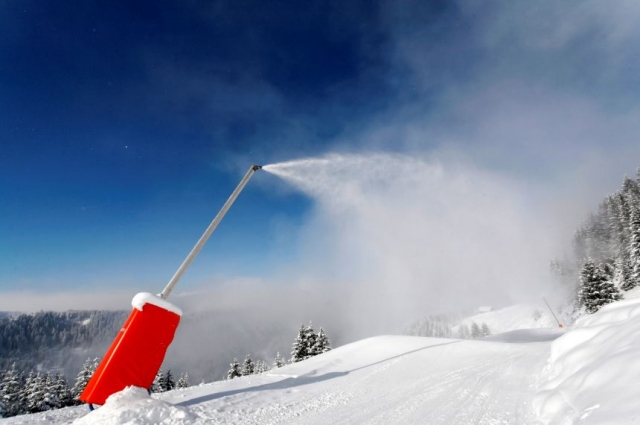Winter sports feature their own specific competitions for each type of sport. In the case of skiing, we can find competitions such as aerials. Each competition consists of two different jumps performed on specially prepared ramps. Judges must observe and score the take-off, the correct execution of movements during the jump, and the landing. Different jumps are those with varying numbers of rotations, twists, or changes in the direction of rotation.

We can distinguish two types of jumps:
- Straight jumps: equivalent to those performed in mogul competitions. A maximum of 5 figures can be executed. The specific ramp for this type of jump is called a "floater". These jumps are very long but not as high as somersaults.
- Inverted jumps: the skier performs a maximum of 3 somersaults. In this case, the ramp is called a "kicker" and is designed to propel the skier upwards to provide the necessary height. There are different sizes depending on the number of somersaults and rotations to be performed. We will focus on this type of jump.
Kicker. The score is divided into 3 sections:
1. Air
This accounts for 20% of the score (minimum 0.0 / maximum 2.0). This category considers the take-off (10% of the total) and the height and distance (another 10%). The take-off refers to how the jumper initiates the jump, extending their body just as they leave the kicker. It is judged from the moment they enter the transition zone until the skis leave the ramp, with emphasis on ensuring rotations do not begin until after leaving the ramp.

The height and distance result from the speed at entry and the force of the take-off. These should be evaluated based on the trajectory and landing point. The optimal landing point should be as far from the knoll as the jump itself. Here are some approximate measurements:
- Small jumps: about 4 metres.
- Medium jumps: about 6 metres.
- Large jumps: about 8 metres.
- Floater: about 10 metres.
A jumper can receive maximum points as long as they land before the transition zone leading to the outrun.
2. Take-off
Form. This accounts for 50% of the score (minimum 0.0 / maximum 5.0). Form evaluates the position of the body, arms, and legs in the air—essentially, the execution of the jump. It is assessed based on precision (body extension and economy of movement), balance, stability, and coordination of the manoeuvre. Judging begins when the ski tails leave the kicker and ends when the jumper touches the snow.
If the number of manoeuvres is not completed, whether in excess or deficit, the competitor will receive no points (RNS = Receives No Score). Judges will divide the total score by the number of manoeuvres, deducting points proportionally if any part of the jump is not performed. For example, if the jumper announces a Lay-Tuck (we’ll explain this later) but executes a Lay-Lay, the maximum points they can receive for form will be 2.5 (50% of the total).

Form breaks. Deductions are applied based on the severity of the break, whether throughout the jump or in part of the manoeuvre(s). The following guidelines are used for deductions:
- Minor breaks: up to 25% of possible points.
- Moderate breaks: up to 50% of possible points.
- Major breaks: up to 100% of possible points.
What criteria are used to classify breaks? Any variation of less than 45 degrees from the basic form is considered minor. If it is approximately 45 degrees, it is moderate, and if clearly greater than 45 degrees, it is severe. Deductions are cumulative. Multiple minor breaks can result in a major break.
3. Landing
This accounts for 30% of the score (minimum 0.0 / maximum 3.0). A correct landing involves a stable, balanced, and controlled body position. The jumper must demonstrate precision with minimal disruption upon contact with the snow. Absorption should primarily be done with the knees and lower body, with only a slight bend at the waist. Landing evaluation begins when the jumper touches the snow and continues until they demonstrate sufficient control after landing.
It is divided into two parts:
- Landing: This refers to the body position relative to the slope, ski-snow contact, and body absorption (maximum 2.0 points). A perfect landing is one where the body is extended at 90 degrees to the slope, perfectly balanced, with weight centred on the skis and rotations fully stopped.
- Exit: From snow contact until the outrun. The exit will receive maximum points (1.0 point) if controlled, with no body contact on the snow, weight on both skis, and a straight exit from the landing. At least 0.1 points must be awarded for the landing to qualify for exit points.

Preparation for the landing will influence the form score.
Jumps are primarily categorised in 3 ways:
1. Based on the direction of rotation upon leaving the kicker: front-back2. Based on body position (2 options):
- Layout: the body is fully extended. Legs straight and together.
- Tuck: legs bent at the hip and knee at an angle of at least 90 degrees. For forward somersaults, this angle is usually greater.
3. With or without rotations (twists): these are spins around the body's vertical axis and are always executed in the layout position.
Lay
Depending on the jump's difficulty, it will be assigned a difficulty coefficient, which, when applied to the execution points awarded by the judges, will determine the jumper's final score. If the jumper loses one or both skis after take-off but before landing (i.e., during flight), they may jump again (if able). If they do not jump again, the score will be RNS. Loss of a ski during or after landing will be judged according to standard criteria.











